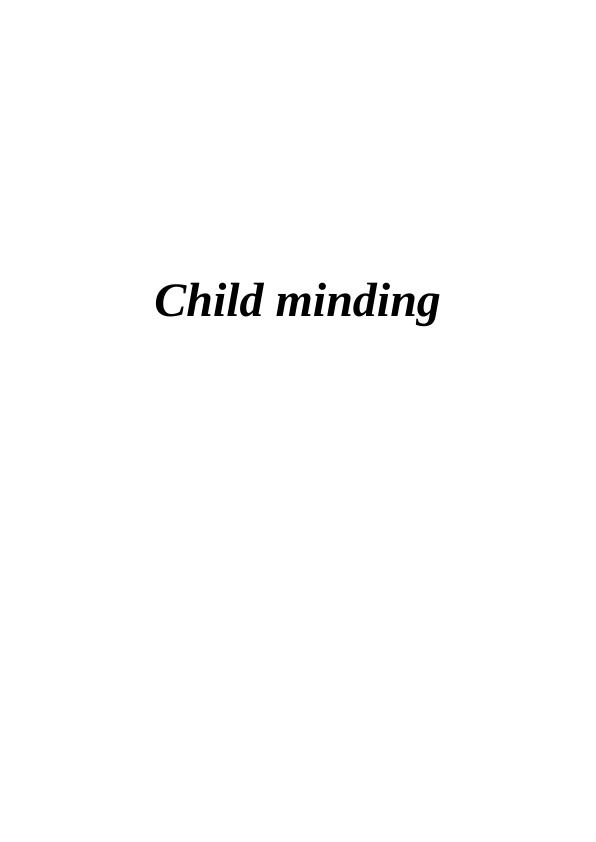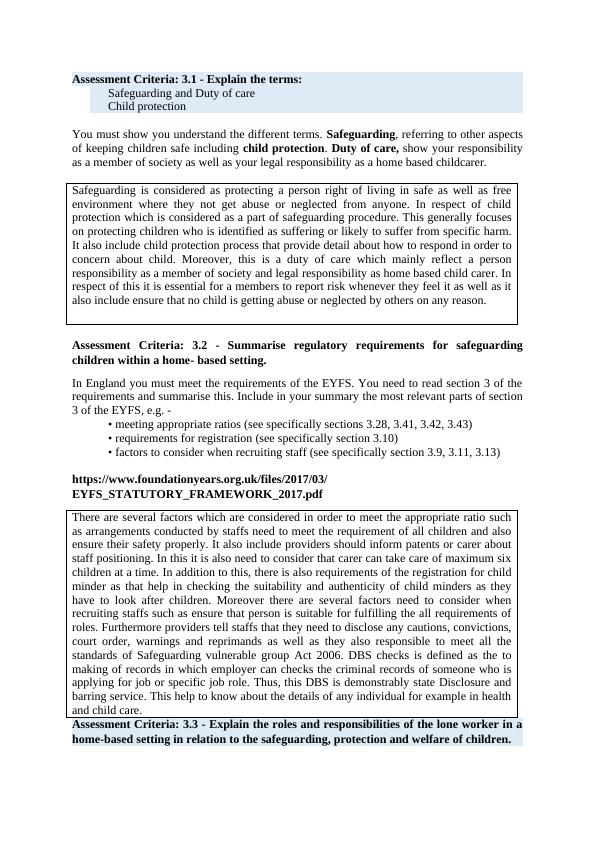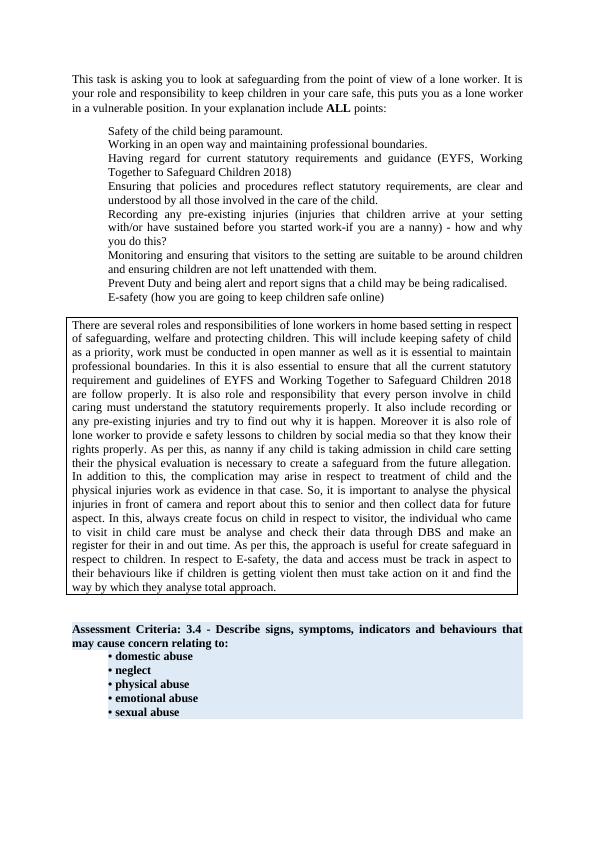Child Minding: Safeguarding and Duty of Care
Added on 2022-12-28
6 Pages2050 Words1 Views
Child minding

Assessment Criteria: 3.1 - Explain the terms:
Safeguarding and Duty of care
Child protection
You must show you understand the different terms. Safeguarding, referring to other aspects
of keeping children safe including child protection. Duty of care, show your responsibility
as a member of society as well as your legal responsibility as a home based childcarer.
Safeguarding is considered as protecting a person right of living in safe as well as free
environment where they not get abuse or neglected from anyone. In respect of child
protection which is considered as a part of safeguarding procedure. This generally focuses
on protecting children who is identified as suffering or likely to suffer from specific harm.
It also include child protection process that provide detail about how to respond in order to
concern about child. Moreover, this is a duty of care which mainly reflect a person
responsibility as a member of society and legal responsibility as home based child carer. In
respect of this it is essential for a members to report risk whenever they feel it as well as it
also include ensure that no child is getting abuse or neglected by others on any reason.
Assessment Criteria: 3.2 - Summarise regulatory requirements for safeguarding
children within a home- based setting.
In England you must meet the requirements of the EYFS. You need to read section 3 of the
requirements and summarise this. Include in your summary the most relevant parts of section
3 of the EYFS, e.g. -
• meeting appropriate ratios (see specifically sections 3.28, 3.41, 3.42, 3.43)
• requirements for registration (see specifically section 3.10)
• factors to consider when recruiting staff (see specifically section 3.9, 3.11, 3.13)
https://www.foundationyears.org.uk/files/2017/03/
EYFS_STATUTORY_FRAMEWORK_2017.pdf
There are several factors which are considered in order to meet the appropriate ratio such
as arrangements conducted by staffs need to meet the requirement of all children and also
ensure their safety properly. It also include providers should inform patents or carer about
staff positioning. In this it is also need to consider that carer can take care of maximum six
children at a time. In addition to this, there is also requirements of the registration for child
minder as that help in checking the suitability and authenticity of child minders as they
have to look after children. Moreover there are several factors need to consider when
recruiting staffs such as ensure that person is suitable for fulfilling the all requirements of
roles. Furthermore providers tell staffs that they need to disclose any cautions, convictions,
court order, warnings and reprimands as well as they also responsible to meet all the
standards of Safeguarding vulnerable group Act 2006. DBS checks is defined as the to
making of records in which employer can checks the criminal records of someone who is
applying for job or specific job role. Thus, this DBS is demonstrably state Disclosure and
barring service. This help to know about the details of any individual for example in health
and child care.
Assessment Criteria: 3.3 - Explain the roles and responsibilities of the lone worker in a
home-based setting in relation to the safeguarding, protection and welfare of children.
Safeguarding and Duty of care
Child protection
You must show you understand the different terms. Safeguarding, referring to other aspects
of keeping children safe including child protection. Duty of care, show your responsibility
as a member of society as well as your legal responsibility as a home based childcarer.
Safeguarding is considered as protecting a person right of living in safe as well as free
environment where they not get abuse or neglected from anyone. In respect of child
protection which is considered as a part of safeguarding procedure. This generally focuses
on protecting children who is identified as suffering or likely to suffer from specific harm.
It also include child protection process that provide detail about how to respond in order to
concern about child. Moreover, this is a duty of care which mainly reflect a person
responsibility as a member of society and legal responsibility as home based child carer. In
respect of this it is essential for a members to report risk whenever they feel it as well as it
also include ensure that no child is getting abuse or neglected by others on any reason.
Assessment Criteria: 3.2 - Summarise regulatory requirements for safeguarding
children within a home- based setting.
In England you must meet the requirements of the EYFS. You need to read section 3 of the
requirements and summarise this. Include in your summary the most relevant parts of section
3 of the EYFS, e.g. -
• meeting appropriate ratios (see specifically sections 3.28, 3.41, 3.42, 3.43)
• requirements for registration (see specifically section 3.10)
• factors to consider when recruiting staff (see specifically section 3.9, 3.11, 3.13)
https://www.foundationyears.org.uk/files/2017/03/
EYFS_STATUTORY_FRAMEWORK_2017.pdf
There are several factors which are considered in order to meet the appropriate ratio such
as arrangements conducted by staffs need to meet the requirement of all children and also
ensure their safety properly. It also include providers should inform patents or carer about
staff positioning. In this it is also need to consider that carer can take care of maximum six
children at a time. In addition to this, there is also requirements of the registration for child
minder as that help in checking the suitability and authenticity of child minders as they
have to look after children. Moreover there are several factors need to consider when
recruiting staffs such as ensure that person is suitable for fulfilling the all requirements of
roles. Furthermore providers tell staffs that they need to disclose any cautions, convictions,
court order, warnings and reprimands as well as they also responsible to meet all the
standards of Safeguarding vulnerable group Act 2006. DBS checks is defined as the to
making of records in which employer can checks the criminal records of someone who is
applying for job or specific job role. Thus, this DBS is demonstrably state Disclosure and
barring service. This help to know about the details of any individual for example in health
and child care.
Assessment Criteria: 3.3 - Explain the roles and responsibilities of the lone worker in a
home-based setting in relation to the safeguarding, protection and welfare of children.

This task is asking you to look at safeguarding from the point of view of a lone worker. It is
your role and responsibility to keep children in your care safe, this puts you as a lone worker
in a vulnerable position. In your explanation include ALL points:
Safety of the child being paramount.
Working in an open way and maintaining professional boundaries.
Having regard for current statutory requirements and guidance (EYFS, Working
Together to Safeguard Children 2018)
Ensuring that policies and procedures reflect statutory requirements, are clear and
understood by all those involved in the care of the child.
Recording any pre-existing injuries (injuries that children arrive at your setting
with/or have sustained before you started work-if you are a nanny) - how and why
you do this?
Monitoring and ensuring that visitors to the setting are suitable to be around children
and ensuring children are not left unattended with them.
Prevent Duty and being alert and report signs that a child may be being radicalised.
E-safety (how you are going to keep children safe online)
There are several roles and responsibilities of lone workers in home based setting in respect
of safeguarding, welfare and protecting children. This will include keeping safety of child
as a priority, work must be conducted in open manner as well as it is essential to maintain
professional boundaries. In this it is also essential to ensure that all the current statutory
requirement and guidelines of EYFS and Working Together to Safeguard Children 2018
are follow properly. It is also role and responsibility that every person involve in child
caring must understand the statutory requirements properly. It also include recording or
any pre-existing injuries and try to find out why it is happen. Moreover it is also role of
lone worker to provide e safety lessons to children by social media so that they know their
rights properly. As per this, as nanny if any child is taking admission in child care setting
their the physical evaluation is necessary to create a safeguard from the future allegation.
In addition to this, the complication may arise in respect to treatment of child and the
physical injuries work as evidence in that case. So, it is important to analyse the physical
injuries in front of camera and report about this to senior and then collect data for future
aspect. In this, always create focus on child in respect to visitor, the individual who came
to visit in child care must be analyse and check their data through DBS and make an
register for their in and out time. As per this, the approach is useful for create safeguard in
respect to children. In respect to E-safety, the data and access must be track in aspect to
their behaviours like if children is getting violent then must take action on it and find the
way by which they analyse total approach.
Assessment Criteria: 3.4 - Describe signs, symptoms, indicators and behaviours that
may cause concern relating to:
• domestic abuse
• neglect
• physical abuse
• emotional abuse
• sexual abuse
your role and responsibility to keep children in your care safe, this puts you as a lone worker
in a vulnerable position. In your explanation include ALL points:
Safety of the child being paramount.
Working in an open way and maintaining professional boundaries.
Having regard for current statutory requirements and guidance (EYFS, Working
Together to Safeguard Children 2018)
Ensuring that policies and procedures reflect statutory requirements, are clear and
understood by all those involved in the care of the child.
Recording any pre-existing injuries (injuries that children arrive at your setting
with/or have sustained before you started work-if you are a nanny) - how and why
you do this?
Monitoring and ensuring that visitors to the setting are suitable to be around children
and ensuring children are not left unattended with them.
Prevent Duty and being alert and report signs that a child may be being radicalised.
E-safety (how you are going to keep children safe online)
There are several roles and responsibilities of lone workers in home based setting in respect
of safeguarding, welfare and protecting children. This will include keeping safety of child
as a priority, work must be conducted in open manner as well as it is essential to maintain
professional boundaries. In this it is also essential to ensure that all the current statutory
requirement and guidelines of EYFS and Working Together to Safeguard Children 2018
are follow properly. It is also role and responsibility that every person involve in child
caring must understand the statutory requirements properly. It also include recording or
any pre-existing injuries and try to find out why it is happen. Moreover it is also role of
lone worker to provide e safety lessons to children by social media so that they know their
rights properly. As per this, as nanny if any child is taking admission in child care setting
their the physical evaluation is necessary to create a safeguard from the future allegation.
In addition to this, the complication may arise in respect to treatment of child and the
physical injuries work as evidence in that case. So, it is important to analyse the physical
injuries in front of camera and report about this to senior and then collect data for future
aspect. In this, always create focus on child in respect to visitor, the individual who came
to visit in child care must be analyse and check their data through DBS and make an
register for their in and out time. As per this, the approach is useful for create safeguard in
respect to children. In respect to E-safety, the data and access must be track in aspect to
their behaviours like if children is getting violent then must take action on it and find the
way by which they analyse total approach.
Assessment Criteria: 3.4 - Describe signs, symptoms, indicators and behaviours that
may cause concern relating to:
• domestic abuse
• neglect
• physical abuse
• emotional abuse
• sexual abuse

End of preview
Want to access all the pages? Upload your documents or become a member.
Related Documents
Child Minding: Safeguarding, Duty of Care, and Child Protectionlg...
|6
|1710
|49
Safeguarding Protection and Welfare of Babies and Young Children in Early Years Settingslg...
|11
|3808
|335
Child Care Policies - PDFlg...
|9
|1956
|220
Childcare Assessmentlg...
|35
|12250
|44
Laws and Regulations for the Protection of Children and Young Peoplelg...
|7
|2648
|58
Health and Safety in Child Care Settings - EYFSlg...
|7
|2060
|334
